
scrounge: /skrounj/ informal verb: to actively seek [books] from any available source
This past year we used Telling God’s Story for our Bible curriculum. The lesson book was written by Dr. Peter Enns, and the accompanying Student Guide & Activity Pages book was edited by Justin Moore and includes content by several contributors. These were published by Olive Branch Books, which is an imprint of Well-Trained Mind – a respected name in the homeschool curriculum world.
I’m going to share an overview of how the curriculum works and what it covers, and then some notes about each of the units – subject matter, observations from our schooling, and a few examples of crafts and activities included.
I know many choose to go with “just the Bible” for religious studies, which is understandable, but I wanted a bit more direction for young children – something with lessons broken down into reasonable chunks, along with ideas for object lessons to help the stories make sense to them.
Overall I enjoyed using this curriculum. We started with Year 1 which is aimed at first grade. This year simply focuses on “Meeting Jesus.” Rather than starting at the beginning of the Bible, this book anchors the story in Jesus himself as the foundation of Christian faith, allowing the other important parts of the story to fall into place in due time. In the Introduction, Enns notes:
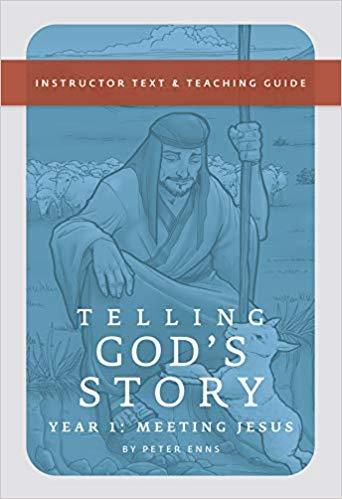
“It is good to remember that the first followers of Jesus were likely far less familiar with the Old Testament than we might think. There were no printed books back then. Peter and others, when they were called by Jesus to follow him, did not have their Bibles open and may not even have been all that familiar with the Scripture’s content. When Jesus came on the scene he did not say, ‘OK, before I begin talking, please open up your Bibles and let me show you how all of this fits together.’ Rather, he came on the scene and just started being Jesus. And the point was made well enough.”
Nevertheless, Enns assumes that those using this curriculum are receiving more comprehensive biblical instruction through a local church, and doesn’t expect this book to provide all of that. Instead, “The purpose of this curriculum is to get to know Jesus better.” I can get behind that.
In fact, I feel like I learned a lot from this as well, even though I’ve grown up in the church. The simplicity of the focus was refreshing, and each lesson in the lesson book provides a “What the Parent Should Know” section before the actual read-aloud portion. In fact, roughly 50% of text in the lesson book is there to set the scene for the parent beforehand. Often these notes had a different take on interpretation of some scenes and parables than I was used to, but this was still helpful in broadening my perspective.
While it’s intended for home use, this could also be used in a small group or Sunday School class. It might not be as flashy and cartoony as many of the more popular curricula, but that’s okay.
To be honest, I’m not a very “crafty” person – I like low-mess projects that help reinforce concepts from lessons, but I don’t have as much tolerance for crafts that seem like busywork or that require a lot of time and resources for minimal results – for me that’s a recipe for homeschool burnout. I also had baby #3 at the beginning of the school year, so that further lowered my motivation for complex projects. Fortunately, I found at least one or two things in each lesson (sometimes more) that were doable for us, or could at least be modified to be simple enough for where we were at.
Format
The 36 lessons are divided into 8 units, each with 4 to 5 weekly lessons. For each unit, I’ll share some of the things that stood out to me, and also some favorite songs that went well with some of the lessons. Many of these are from the "Sing the Bible" albums by Slugs and Bugs (aka Randall Goodgame). We have enjoyed all three albums full of Bible passages put to music. They’re great for the whole family – simple, but not underproduced the way “kid music” sometimes is.
Stories Jesus Told
The first story is the parable of the woman and the lost coin, which emphasizes the joy that God feels when a sinner comes to him. Since stories resonate with children, and Jesus used them a lot, this is a great place to start. We enjoyed the “lost coin” activity which involved hunting for coins in a tray of sand, and then writing the letters from the coins onto paper to complete a sentence that reminds us God is joyful over us.
The “What is a tax collector?” demonstration from lesson 4 was fun and effective, and I think my favorite craft in this unit was the mustard seed tree with mustard seeds glued to it – it’s such a fitting visual reminder of how small things can grow! (Also: I’m thankful that mustard seeds are not glitter.)
Songs:
Lesson 3: "Mustard Seed," Track 14 on Sing the Bible Volume 3
Lesson 4: "A Breath of a Prayer" by Michael Card, Track 7 on his "Luke" album
Lesson 5: "The Ninety and Nine" by Andrew Peterson, Track 10 on "Carried Along"
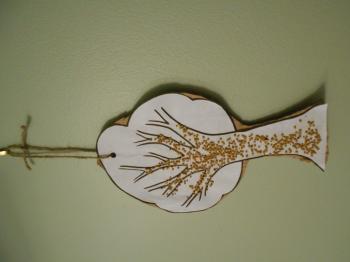
Miracles Jesus Did
This unit starts the process of teaching the names of the New Testament books as a memorization project. We used the New Testament song from “Sing the Bible Volume 1” to help with this, though there is also a good song on the Wee Sing Bible Songs album (that’s the one I grew up with).
We enjoyed the “Sea of Galilee in a bottle” project from lesson 7, and the “Why does it sink or float?” activity in lesson 9 combined well with some of our other science projects this year. Other activities include a maze, and a Roman centurion’s helmet made out of a milk jug!
Teachings of Jesus
In the intro to this unit, Enns really hits on something that I hadn’t thought of in those terms before, but made total sense once I read it:
“Although few would put it this way deliberately, it seems to be a common assumption that the story of Jesus is mainly about a miraculous birth and his atoning death – with some filler material that bears indirectly somehow on what “the Gospel” is. But the teachings that Jesus gave to his disciples and others who came to hear him are more than filler. They are an expression of why he came in the first place.”
This emphasizes to me again why it’s so important for young children to see Jesus – who he is, what he did, why we follow him. Nothing else we learn about the Bible could be more important than that.
I’m glad that the story of Jesus blessing the children was included here (lesson 11), and it was especially helpful that it introduced the concept of a “blessing” by looking at Numbers 6:24-26, and included a coloring page with the words on it. This lesson also incorporated a look at Carl Bloch’s painting of this scene, and is one of several lessons that use art history to further explore a story.
Lesson 15 emphasizes that all believers are part of Jesus’s family, based on his statement in Luke 8.
Songs:
Lesson 11: "Let the Children Come to Me," Track 3 on Sing the Bible Volume 3
The Sermon on the Mount
I appreciate that this short portion of Scripture got its own unit. So many teachings here make for great object lessons, such as salt and light (lesson 16, which includes a “Salt of the Earth” picture made with salt and colored chalk), and the “lilies of the field” (lesson 19, which includes paper dolls that show what both rich and poor people wore in those days).
Lesson 20 includes a picture of the Golden Rule to decorate – when it comes to glitter, I recommend glitter glue – it makes less of a mess!
Songs:
Lesson 16: "You Are the Light of the World," Godspell
Lesson 19: "Do Not Worry," Track 12 on Sing the Bible Volume 2
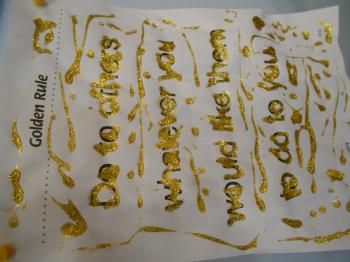
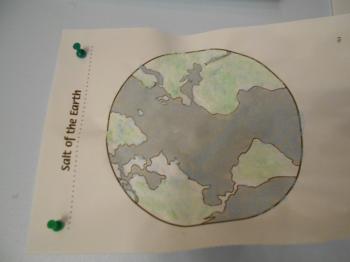
Jesus’ Early Life
We followed a suggestion in the Introduction to do this unit during Advent, and that worked well, even though the last two lessons involve things that happened after Jesus’s birth (escaping to Egypt and then returning). O Come, O Come, Emmanuel is one of my favorite Christmas carols, so I enjoyed the project that involved reading and explaining each verse of that hymn while my son colored in a picture of a key element (lesson 21). We also enjoyed the scavenger hunt in that lesson, and the picture study of Tanner’s The Annunciation.
Songs:
Lesson 21: "O Come, O Come, Emmanuel" Orla Fallon
Lesson 22: "We Three Kings" Celtic Woman
Jesus’ Disciples
This unit begins a memory project of the disciples’ names. The fishing activity in lesson 25 was fun (rod with magnet + paperclip fish), and I appreciated the object lesson in lesson 26 that emphasized how we shouldn’t judge solely by appearances.
I love that lesson 28 was about Mary and Martha – I’d never thought of them as Jesus’s “disciples” before, but why not? I’m grateful for the chance to help children see that following Jesus was not just a “man thing”!
Opposition to Jesus
I like how lesson 29, on Jesus’s temptation, includes an activity about Herod’s temple to give some historical context to this and other stories. I appreciated one project that taught some basic things about what a synagogue looked like and what the worship time was like. This was an opportunity to talk about the Shema from Deuteronomy 6.
Songs:
Lesson 29: "Not by Bread Alone," Track 9 on Sing the Bible Volume 3
Lesson 30: "Hear, O Israel," Track 7 on Sing the Bible Volume 2; "Deuteronomy 6:5," Track 4 on Sing the Bible Volume 1
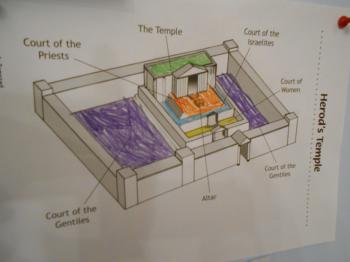
The End of Jesus’ Life
This unit could also be shifted around to accommodate Lent and Holy Week, but I didn’t pre-plan enough for that and thought it would break up the continuity of the story too much. So we finished the school year with this unit and then used the 3 supplemental lessons during the last week to make sure that the story ended with Jesus’s resurrection. I actually liked the opportunity to review some of what the kids had heard and seen over Holy Week, since it was recent enough that it was still somewhat fresh in their minds.
Lesson 33 involves learning the Sanctus, which was interesting for a Baptist like me who has no high-church background. I found a version I really liked by a boys’ choir called Libera, and my kids liked the video of the song that was filmed in a cathedral. It doesn’t quite cover all the words from the triumphal entry though.
We liked the projects in lesson 34 that focused on figs, especially the recipe for homemade fig newtons. The perfume-making project in lesson 36 was fun too, and pretty simple.
My first-grader enjoyed this curriculum, and I'm glad we used it. We're using Year 2 right now and seeing how it goes with a Pre-Ker as well, so I'll plan on reviewing that one as well.
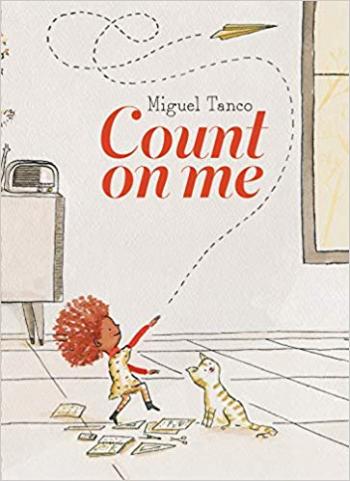
The unnamed girl in Count on Me begins by telling us that everyone has a passion. She shows some of her family members' passions, as well as some of the things she tried that just weren't for her. Then she reveals what her passion is: math. She enjoys looking for it in the world around her, in the form of geometric playground equipment, concentric circles in the water, etc. While this section of the book doesn't go into a lot of detail about mathematical concepts, it serves to present math as a way of seeing the world, as well as to normalize it as something for a girl to do.
At the end of the book, there are several pages describing in more detail how to look for different kinds of math in the real world: fractals, projections, polygons, etc. This section was helpful and gives a more tangible picture of how ubiquitous math is when you know how to look for it. (Despite the title, counting isn't really discussed here.) We enjoyed this book very much, and the watercolor art is beautiful.
(In compliance with FTC guidelines, I disclose that I received this book for free through LibraryThing Early Reviewers. I was not required to write a positive review.)
Scrounged From: LibraryThing
Format: Hardcover
Author/Illustrator: Miguel Tanco
Pages: 48
Content Advisory: None
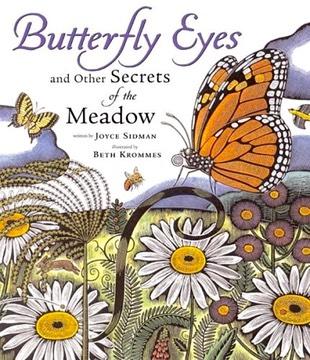
We enjoyed Joyce Sidman's nature poetry in Winter Bees (review here), and were glad to find another collection with a spring theme in Butterfly Eyes and Other Secrets of the Meadow, which we read to finish out the school year this year.
These poems also work as riddles. Each page contains two poems about different aspects of nature in the meadow -- sometimes rodents or bugs, but other times nonliving things like sun and rain. The two answers to the riddle are connected somehow (and described in prose on the page after each riddle), sometimes in more obvious ways than others (butterflies and milkweed, for example), but overall this book helps to show the interconnectedness of all parts of nature when they inhabit the same environment.
The illustrator here is the same as in Swirl by Swirl (review here), but I think the colors are lighter and brigher, and the contrast of the dark lines makes them stand out all the more.
A lovely investigation into nature in spring!
Scrounged From: A used book sale
Format: Hardcover
Author: Joyce Sidman
Illustrator: Beth Krommes
Pages: 48
Content Advisory: None
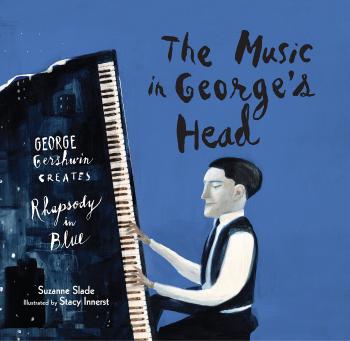
While living in the UK, my family somehow acquired a cassette tape (yes, this was in the 90s) at a gas station (or petrol, as they called it there) called "Miles of Classical." It contained several well-known orchestral pieces of music, including Strauss's "Blue Danube," a movement from Tchaikovsky's "Swan Lake," and, the fifth and last piece on side 1 of the cassette, George Gershwin's "Rhapsody in Blue," or at least an abbreviated version of it.
Other than "The Nutcracker," I didn't have much love for orchestral music, but listening to that cassette over and over and over on long drives really helped me and my siblings to develop more appreciation for some of these favorites. I'm still not sure I really "understand" jazz music, but Gershwin's piece was definitely my favorite on that cassette. It reminded me at various points of a morning sunrise and a predator/prey chase scene. The piano solo always amazed me. I would try to visualize the showmanship and talent that a piece like that must require. It wasn't until adulthood that I heard the piece in full, and also learned that Gershwin gave the opening notes to a clarinet rather than a saxophone, which made me like him even more (I took clarinet lessons in high school but never did anything cool like that with it).
So when I heard there was a book out called The Music in George's Head: George Gershwin Creates Rhapsody in Blue, I knew I had to procure it someday. There were few pieces of music that I would have been more interested in learning about than this one, but I also wondered how the translation of jazz-to-picture-book would go.
I think it's fabulous. Everything is drawn in shades of blue with some earth tones thrown in -- gray-blues on the city streets, navy blue swirls of musical notes and piano keys, baby blues for people and sheets of music.. the whole book comes alive in a jazz-blue world, where it recounts factual information but also skips and bumps along at times with a steady, jazzy feel. Most of the text is written in a normal cadence and is not difficult to understand or read, but sometimes we have a "rattle-ty bang" of train tracks or the "WuaaaAAA..." of the clarinet.
"Sleepy eyes flew open. Restless listeners sat still. People heading for the door hurried back to their seats. Trombones and trumpets blew brassy sounds -- small and soft, then big and bright. Velvety violins started to sing. More musicians joined in. Each carefully playing their sheets of music. Fingers flying, George made those piano keys MARCH. SKIP. Dance. But he didn't have sheet music. George played the notes in his head."
Wish I could've been there!
Scrounged From: PaperbackSwap.com
Format: Hardcover
Author: Suzanne Slade
Illustrator: Stacy Innerst
Pages: 48
Content Advisory: None
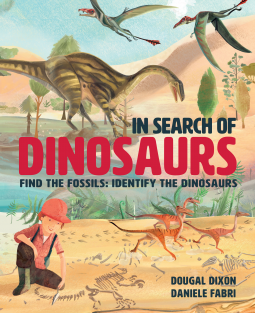
Living with a dinosaur fan can be fun, and I know I've been exposed to and learned so much more about dinosaurs and fossils than I ever did as a kid, thanks to my son taking an interest in them. In Search of Dinosaurs is a dinosaur book that helps to make some connections between the artistic recreations of Mesozoic animals that we see and the fossil dig sites where information about these creatures and environments is collected.
There is a section for each of the three time periods in the Mesozoic Era, and each follows the same format. First we see an artist's recreation of a hypothetical fossil dig. On the next few pages, we see scenes (without text) of what these animals may have looked like when they were alive. This gives readers the opportunity to go back and forth between the fossils and creatures and see if they can figure out which of the living creatures (or parts of them) are represented in the dig.
These scenes are followed by smaller pictures and information blurbs about each creatures -- mostly dinosaurs, but also some other animals such as Cretaceous turtles, as well as ammonites, metaposaurus, a small mammal, etc. There are plenty of good tidbits of information here, but they're presented in a way that's easy to follow. Since the fossils are presented "in context," we also learn a bit more about the kinds of things paleontologists find in digs, and some of the ways they can find clues as to the dinosaurs' behaviors and environments.
(Thanks to NetGalley for the review copy.)
Scrounged From: NetGalley
Format: Kindle
Author: Dougal Dixon
Pages: 44
Content Advisory: None


